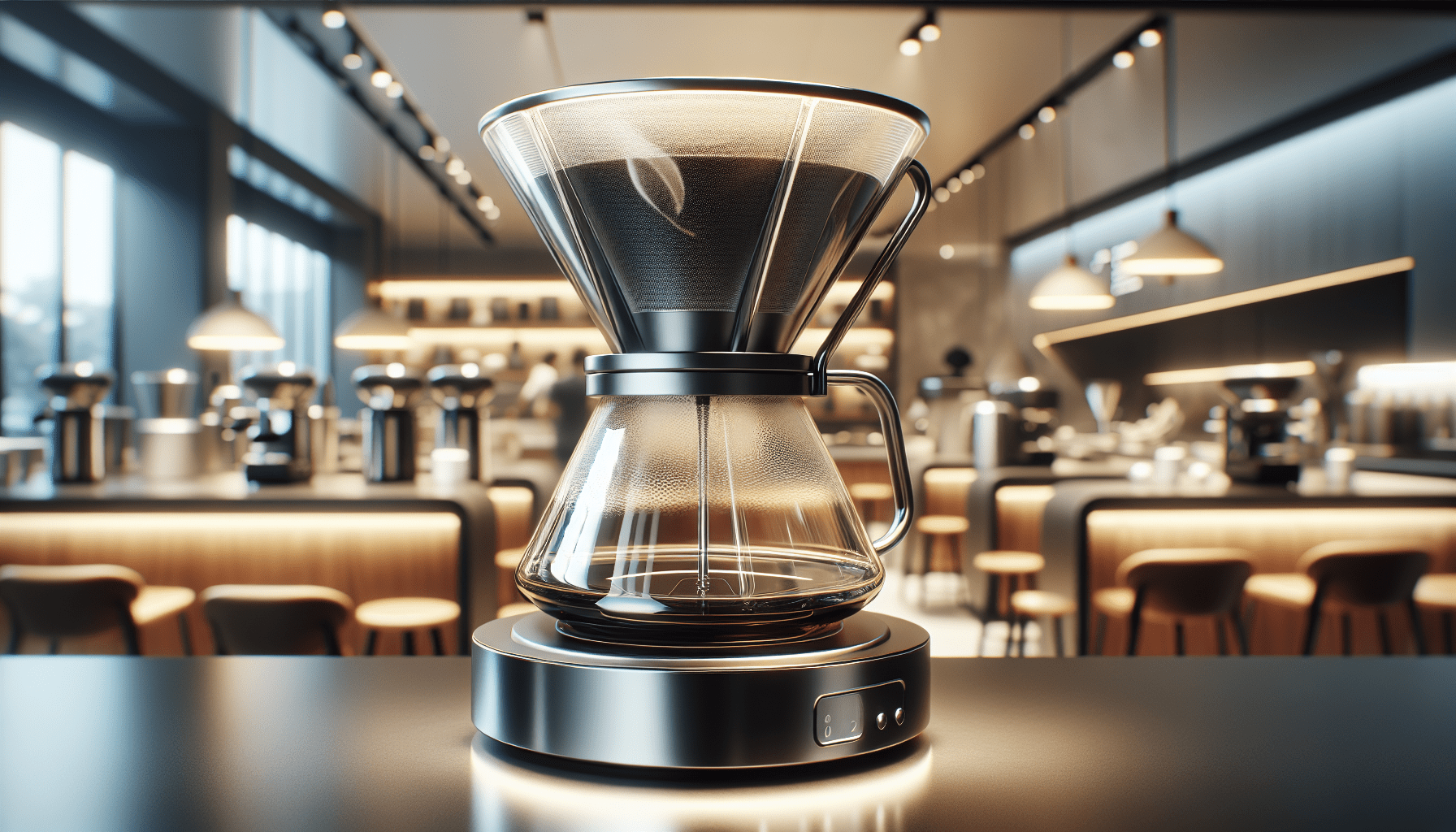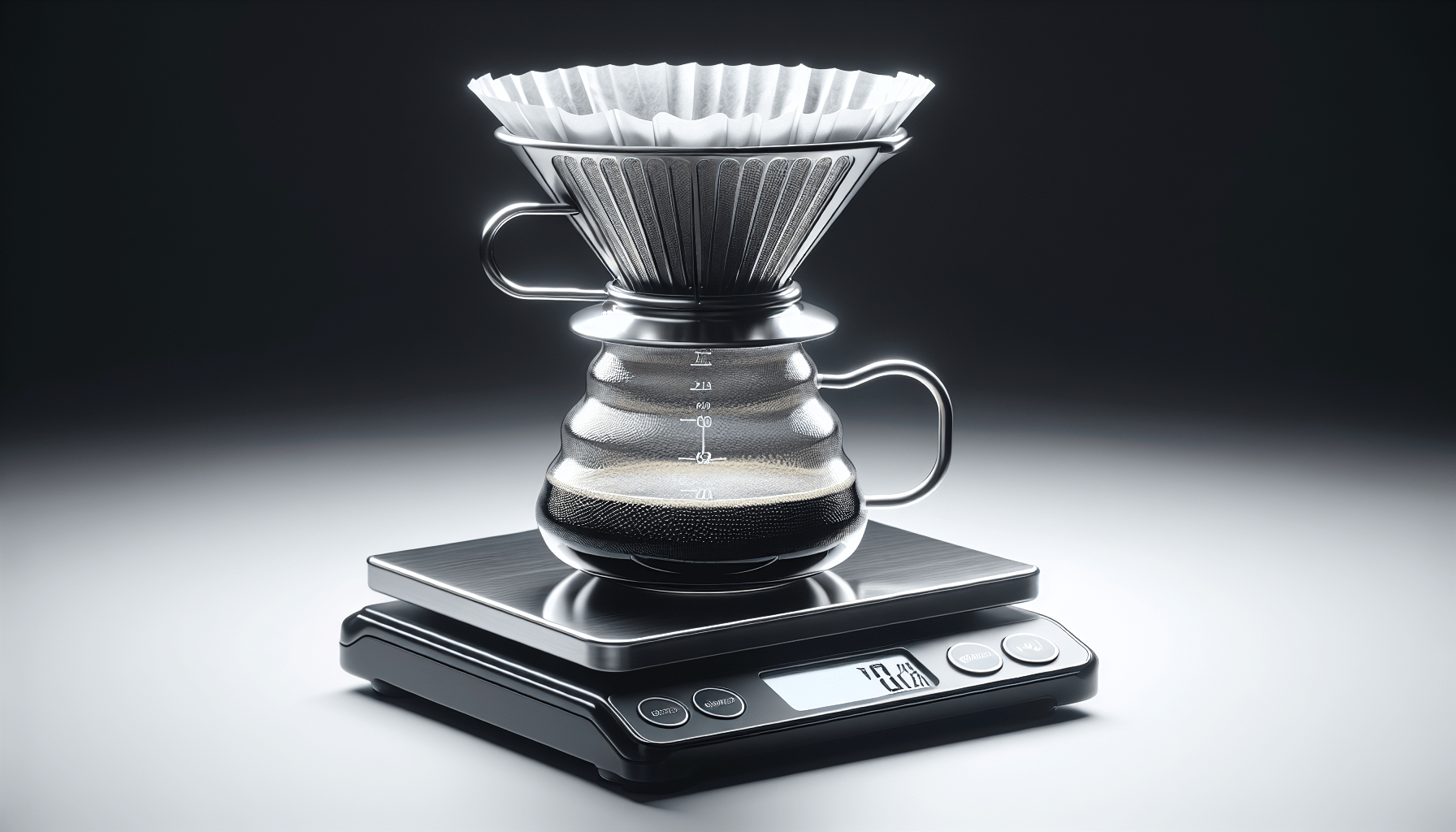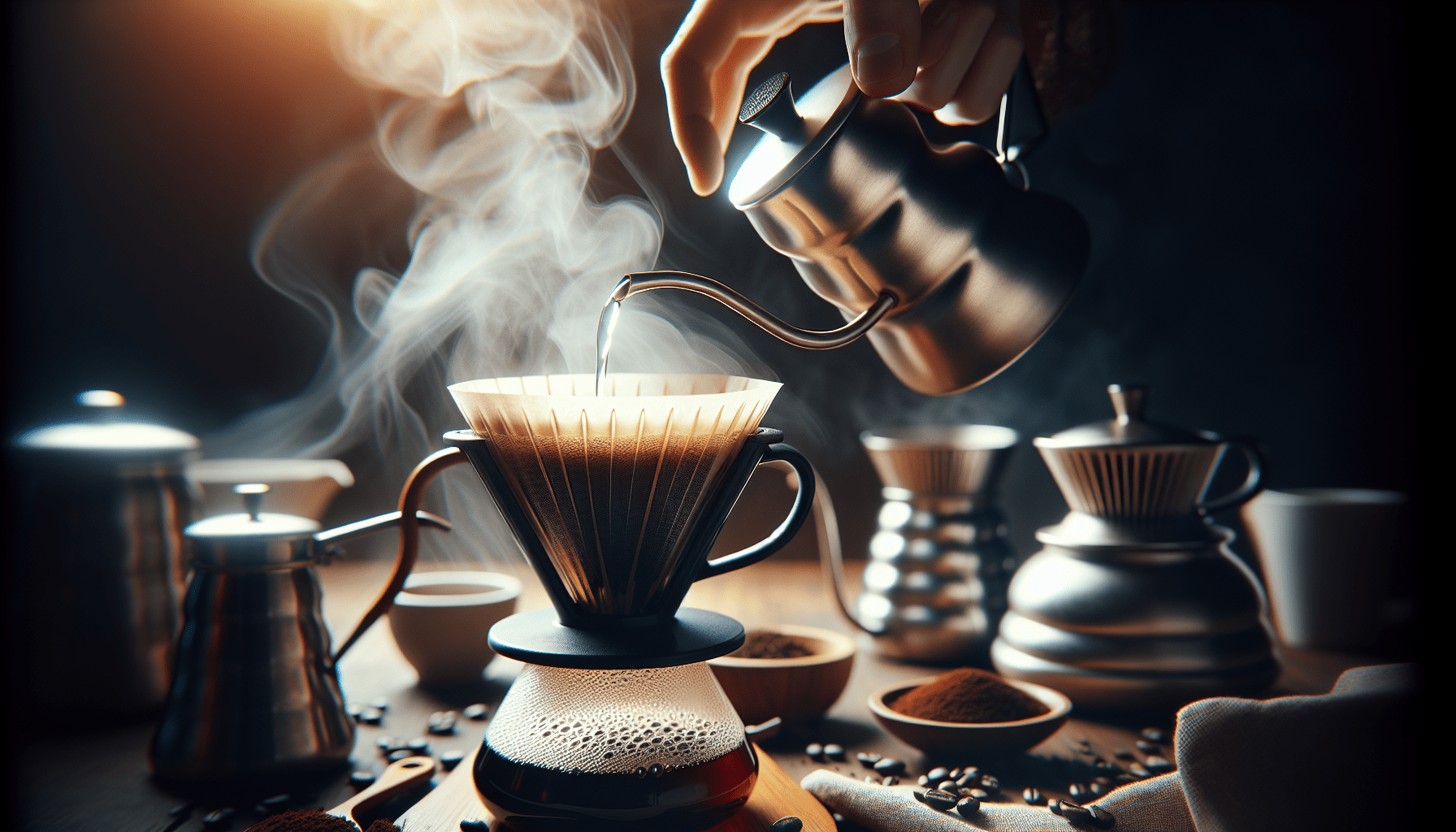Have you ever wondered about the inner workings of a pour-over coffee maker? It’s a simple, yet ingenious device that brings out the rich flavors and aromas in each cup of coffee. By letting hot water slowly pour over freshly ground coffee beans, it allows for a slow extraction process that enhances the taste and clarity of your brew. In this article, we’ll take a closer look at how a pour-over coffee maker functions and why it has become a favorite among coffee aficionados. So grab your mug and let’s explore the fascinating world of pour-over coffee together!
The Basics of Pour-over Coffee
What is a pour-over coffee maker?
A pour-over coffee maker is a manual brewing device that allows you to make a delicious cup of coffee by pouring hot water over coffee grounds. It consists of a dripper, a filter, and a kettle. The pour-over method is known for its simplicity and ability to extract the full flavor and aroma of the coffee.
Why use a pour-over coffee maker?
There are several reasons why many coffee enthusiasts prefer using a pour-over coffee maker. Firstly, it offers a more hands-on brewing experience, allowing you to have full control over the entire brewing process. Secondly, using a pour-over coffee maker allows for the extraction of a cleaner and more nuanced flavor compared to other brewing methods. Lastly, it is a versatile brewing method that allows you to customize your coffee according to your preferences.
The science behind pour-over coffee
The science behind pour-over coffee lies in the extraction process. As hot water comes into contact with the coffee grounds, it extracts the soluble compounds responsible for the flavors and aromas we associate with coffee. The pour-over method ensures a uniform extraction by evenly saturating the coffee grounds, resulting in a well-balanced and flavorful cup of coffee.
Components of a Pour-over Coffee Maker
Dripper
The dripper is the main component of a pour-over coffee maker. It is typically cone-shaped and made of materials such as ceramic, glass, or plastic. The shape of the dripper promotes a slower water flow, allowing for optimal extraction of the coffee grounds. Different drippers may have unique design features, but they all serve the same purpose of holding the filter and coffee grounds.
Filter
The filter is used to separate the coffee grounds from the brewed coffee. It plays a crucial role in ensuring a clean and sediment-free cup of coffee. There are various types of filters available, including paper filters, metal filters, and cloth filters. Paper filters are the most commonly used as they effectively remove any fine sediment and oils, resulting in a smoother and clearer cup of coffee.
Coffee grounds
Choosing the right coffee grounds is essential for achieving the perfect pour-over coffee. The grind size should be medium-fine, resembling granulated sugar. This allows for optimal extraction without over or under extracting the coffee. Using freshly ground coffee beans is also recommended to enhance the flavor and aroma of your pour-over coffee.
Kettle
A kettle with a narrow spout is preferred for pour-over coffee as it allows for precise control over the water flow. It is important to heat the water to the appropriate temperature, usually between 195°F to 205°F (90°C to 96°C), for optimal extraction. Using a gooseneck kettle is often recommended for its superior pouring control, ensuring an even and steady pour.
Scale
While not necessary, using a scale can greatly improve your pour-over coffee brewing process. It allows you to accurately measure the coffee grounds and water, ensuring consistency in your brewing ratio. This precision can help you achieve the desired strength and taste in your cup of coffee.
The Pour-over Process
Step 1: Preparing the equipment
Before starting the pour-over process, gather all the necessary equipment. Rinse the dripper and filter with hot water to remove any paper or manufacturing residue. Set up the dripper on top of your coffee mug or carafe. Place the filter in the dripper, making sure it sits snugly.
Step 2: Heating the water
Boil fresh, clean water to the recommended temperature. If using a thermometer, aim for a range between 195°F to 205°F (90°C to 96°C). Heating the water to the correct temperature ensures optimal extraction of the coffee flavors.
Step 3: Pre-wetting the filter
Pour a small amount of the heated water over the filter to pre-wet it. This step helps to remove any papery taste from the filter and preheats the dripper, ensuring a stable brewing temperature.
Step 4: Adding coffee grounds
Measure the desired amount of coffee grounds using a scale or a tablespoon. The standard ratio is 1:16, which means for every gram of coffee, use 16 grams of water. Add the coffee grounds to the filter, evenly distributing them for a consistent extraction.
Step 5: Blooming
Start the pour-over process by pouring a small amount of water, just enough to saturate the coffee grounds. This is known as the “bloom.” Allow the coffee to bloom for approximately 30 seconds, during which carbon dioxide is released, causing the coffee to rise and bubble.
Step 6: Pouring the water
Begin pouring hot water in a slow and controlled manner, starting from the center and spiraling outwards. Keep the water level constant, avoiding any overflow. Maintain a steady stream and aim for a complete saturation of all the coffee grounds.
Step 7: Allowing the coffee to drip
Once you have poured all the water, allow the coffee to drip through the filter into your mug or carafe. The entire brewing process usually takes around 2 to 4 minutes, depending on the desired strength and the size of the pour-over device used.
Step 8: Enjoying your pour-over coffee
Once the coffee has finished dripping, carefully remove the dripper and discard the filter. Your pour-over coffee is now ready to be enjoyed. Take a moment to appreciate the aroma, savor the flavors, and indulge in the unique experience of your handcrafted cup of coffee.
Advantages of Pour-over Coffee
Control over the brewing process
One of the main advantages of using a pour-over coffee maker is the level of control it offers. You have the ability to control the water flow rate, water temperature, coffee-to-water ratio, and brewing time. This control allows you to tailor your brewing process to suit your personal taste preferences and consistently achieve a cup of coffee that satisfies your unique palate.
Enhanced flavor and aroma
Pour-over coffee extraction allows for a more precise and even extraction of the coffee grounds. This results in a cup of coffee that is rich in flavor, aroma, and complexity. The pour-over method minimizes over-extraction or under-extraction, ensuring a well-balanced and satisfying coffee experience.
Ability to customize your coffee
With pour-over coffee, the possibilities for customization are endless. You can experiment with different coffee beans, grind sizes, water temperatures, and pouring techniques to create your perfect cup of coffee. Whether you prefer a bold and strong brew or a smooth and delicate flavor profile, the pour-over method allows you to achieve the desired result by adjusting various factors.
Easy to clean and maintain
Pour-over coffee makers are generally easy to clean and maintain. Since they consist of a few basic components like the dripper, filter, and kettle, cleaning can be done quickly with warm water and mild soap. Regular maintenance, such as replacing the filters and descaling the kettle periodically, ensures that your pour-over coffee maker remains in optimal condition for years to come.
Tips for Making the Perfect Pour-over Coffee
Choosing the right coffee beans
The quality and freshness of the coffee beans greatly contribute to the overall taste of your pour-over coffee. Opt for freshly roasted whole beans and experiment with different origins and roast profiles to discover your preferred flavor profile.
Grinding the coffee to the right consistency
The grind size of the coffee grounds is crucial for a successful pour-over coffee. Aim for a medium-fine grind, similar to granulated sugar. Avoid grinding the coffee too fine, as it can lead to over-extraction, or too coarse, resulting in under-extraction.
Water temperature and quality
The temperature of the water used during the pour-over process significantly impacts the coffee’s flavor. Ensure the water is heated to the recommended temperature range of 195°F to 205°F (90°C to 96°C). Additionally, using filtered water can improve the taste by removing any impurities or chlorine that may alter the flavor of your coffee.
Mastering the pouring technique
The pouring technique plays a crucial role in achieving a well-extracted pour-over coffee. Pour the water in a slow, circular motion, starting from the center and moving outwards in a spiral pattern. This helps to evenly saturate the coffee grounds and ensures a consistent extraction.
Experimenting with ratios
The coffee-to-water ratio is another variable that can be adjusted to your preference. The standard ratio is 1:16, but feel free to experiment with different ratios to find your optimal balance of strength and flavor.
Taking note of brewing time
Timing the brewing process can help you replicate the desired taste in each cup of pour-over coffee. Keep a note of the brewing time for different coffee beans and adjustments made to the water flow rate or grind size. This record will serve as a reference to help you fine-tune your future brews.
Common Mistakes to Avoid
Using the wrong amount of coffee
Using too much or too little coffee can result in an imbalanced and unpleasant taste. Follow the recommended coffee-to-water ratio and adjust accordingly based on your taste preferences.
Pouring water too quickly or too slowly
The speed at which you pour hot water over the coffee grounds can affect the final taste of your pour-over coffee. Pouring too quickly may cause under-extraction, resulting in a weak and insipid brew. On the other hand, pouring too slowly can lead to over-extraction, resulting in a bitter and overpowering flavor.
Neglecting the importance of water temperature
Water temperature is critical for achieving a well-extracted cup of pour-over coffee. Make sure the water is within the recommended temperature range of 195°F to 205°F (90°C to 96°C) to optimize the extraction process.
Underestimating the bloom
The bloom is an important step in the pour-over process as it releases carbon dioxide from the coffee grounds and allows for even extraction. Neglecting this step can result in uneven extraction and a less flavorful cup of coffee. Always give the coffee grounds a short pause to bloom before continuing with the rest of the pour.
Not cleaning the equipment properly
Proper cleaning and maintenance of your pour-over coffee maker is essential to ensure the longevity of your equipment and the quality of your brew. Regularly clean the dripper, filter, and kettle to remove any residue and oils that can accumulate over time.
Popular Pour-over Coffee Maker Brands
Hario V60
The Hario V60 is a popular choice among pour-over coffee enthusiasts. Known for its distinctive cone shape and spiral ridges on the interior, it promotes optimal water flow and even extraction. The Hario V60 is available in various sizes and materials, making it suitable for both personal use at home and professional settings.
Chemex
The Chemex is a visually striking pour-over coffee maker with its hourglass shape and wooden collar. It uses a thick paper filter, resulting in a clean cup of coffee with minimal sediment. The Chemex is known for producing a bright and crisp coffee with a smooth mouthfeel.
Kalita Wave
The Kalita Wave is prized for its unique flat-bottomed dripper, which provides a more consistent water flow and temperature stability. This design feature contributes to an even and balanced extraction, resulting in a flavorful cup of coffee. The Kalita Wave dripper is a great option for those who value simplicity and ease of use.
AeroPress
Although technically not a pour-over coffee maker, the AeroPress is often mentioned alongside other brewing methods due to its popularity among coffee enthusiasts. It uses a combination of immersion and pressure to extract the flavors from the coffee grounds, resulting in a rich and concentrated brew. The AeroPress is known for its versatility and portability, making it an excellent choice for coffee lovers on the go.
Clever Dripper
The Clever Dripper is a convenient and user-friendly pour-over coffee maker that combines the immersion and drip brewing methods. It features a valve at the bottom that allows for controlled extraction and a full-bodied cup of coffee. The Clever Dripper is favored by those who appreciate a more hands-off approach to pour-over brewing.
Comparison with Other Brewing Methods
French press
Compared to the French press, the pour-over method typically produces a cleaner and brighter cup of coffee. The French press uses a full immersion brewing process, allowing for a more robust and oilier brew. The pour-over method, on the other hand, offers greater control over the extraction process, resulting in a more nuanced and lighter-bodied cup of coffee.
Espresso machine
Pour-over coffee and espresso are two distinct brewing methods with different flavor profiles. Espresso is a concentrated brew extracted under high pressure, resulting in a bold and intense flavor. Pour-over coffee, on the other hand, allows for more delicate and nuanced flavors to shine through. While both methods have their merits, pour-over coffee offers a simpler and more accessible brewing process without the need for specialized equipment.
Automatic drip coffee maker
Automatic drip coffee makers are popular for their convenience and ease of use. However, they often lack the level of control and precision that the pour-over method offers. Automatic drip machines typically have preset settings, which may not produce the desired strength or flavor for coffee enthusiasts seeking a more customizable and artisanal brewing experience.
In conclusion, the pour-over method of brewing coffee offers a unique and flavorful experience for coffee lovers. With its simplicity and versatility, you can customize your cup of coffee to your exact preferences. By understanding the basics of pour-over coffee, choosing the right equipment, and mastering the brewing techniques, you can elevate your coffee brewing skills and enjoy a consistently delicious pour-over coffee every time.



